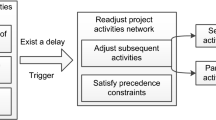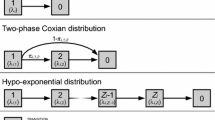Abstract
In this paper, we study the project staffing problem with discrete time/resource trade-offs to minimise the personnel staffing budget. This staffing problem embeds activity scheduling flexibility by incorporating the project scheduling problem into the personnel staffing problem to improve the quality of the staffing plan. In addition, we introduce extra demand scheduling flexibility resulting from the design of alternative execution modes for the activities, modelled via discrete time/resource trade-offs. In this way, the project manager is able to decide on the team size and duration for every activity. We propose a two-stage methodology to first design specific alternative activity modes using heuristic rules-of-thumb and subsequently we assess the resulting quality, i.e. the staffing cost, via the integrated composition of the project schedule and associated staffing plan. The heuristic mode generation rules determine the selection of a limited set of relevant activities and modes. The computational results show that the impact of these heuristic generation rules on the staffing budget is dependent on the defined relation between different activity alternatives for a particular activity and on the estimated characteristics of the activity base modes. We show that by focusing on a particular well-chosen subset of activity alternatives or on a particular subset of activities, high-quality solutions realising most of the potential cost improvements resulting from the discrete time/resource trade-offs can be derived with a reduced effort.




Similar content being viewed by others
References
Alfares, H. K., & Bailey, J. E. (1997). Integrated project task and manpower scheduling. IIE Transactions, 29(9), 711–717.
Alfares, H. K., Bailey, J. E., & Lin, W. (1999). Integrated project operations and personnel scheduling with multiple labour classes. Production Planning and Control, 10, 570–578.
Barnhart, C., Johnson, E. L., Nemhauser, G. L., Savelsbergh, M. W., & Vance, P. H. (1998). Branch-and-price: Column generation for solving huge integer programs. Operations Research, 46(3), 316–329.
Campbell, G. M. (2012). On-call overtime for service workforce scheduling when demand is uncertain. Decision Sciences, 43(5), 817–850.
De, P., Dunne, E. J., Ghosh, J. B., & Wells, C. E. (1995). The discrete time-cost tradeoff problem revisited. European Journal of Operational Research, 81(2), 225–238.
Demeulemeester, E., De Reyck, B., & Herroelen, W. (2000). The discrete time/resource trade-off problem in project networks: A branch-and-bound approach. IIE Transactions, 32(11), 1059–1069.
Demeulemeester, E., Vanhoucke, M., & Herroelen, W. (2003). Rangen: A random network generator for activity-on-the-node networks. Journal of Scheduling, 6(1), 17–38.
Fernandez-Viagas, V., & Framinan, J. M. (2014). Integrated project scheduling and staff assignment with controllable processing times. The Scientific World Journal, 2014, 924120.
Fernandez-Viagas, V., & Framinan, J. M. (2015). Controllable processing times in project and production management: Analysing the trade-off between processing times and the amount of resources. Mathematical Problems in Engineering, 2015, 1–19.
French, S. (1982). Sequencing and scheduling. An Introduction to the Mathematics of the Job-Shop. https://doi.org/10.1016/S0927-0507(05)80189-6.
Fündeling, C.-U., & Trautmann, N. (2010). A priority-rule method for project scheduling with work-content constraints. European Journal of Operational Research, 203(3), 568–574.
Hartmann, S., & Briskorn, D. (2010). A survey of variants and extensions of the resource-constrained project scheduling problem. European Journal of Operational Research, 207(1), 1–14.
Heričko, M., Živkovič, A., & Rozman, I. (2008). An approach to optimizing software development team size. Information Processing Letters, 108(3), 101–106.
Kolisch, R., & Sprecher, A. (1997). PSPLIB—A project scheduling problem library: Or software-orsep operations research software exchange program. European Journal of Operational Research, 96(1), 205–216.
Kolisch, R., Sprecher, A., & Drexl, A. (1995). Characterization and generation of a general class of resource-constrained project scheduling problems. Management Science, 41(10), 1693–1703.
Lanigan, M. (1994). Task estimating: Completion time versus team size. Engineering Management Journal, 4(5), 212–218.
Maenhout, B., & Vanhoucke, M. (2016). An exact algorithm for an integrated project staffing problem with a homogeneous workforce. Journal of Scheduling, 19(2), 107–133.
Maenhout, B., & Vanhoucke, M. (2017). A resource type analysis of the integrated project scheduling and personnel staffing problem. Annals of Operations Research, 252(2), 407–433.
Naber, A., & Kolisch, R. (2014). Mip models for resource-constrained project scheduling with flexible resource profiles. European Journal of Operational Research, 239(2), 335–348.
Ranjbar, M., & Kianfar, F. (2010). Resource-constrained project scheduling problem with flexible work profiles: A genetic algorithm approach. Scientia Iranica Transactions E, Industrial Engineering, 17(1), 25.
Shabtay, D., & Steiner, G. (2007). A survey of scheduling with controllable processing times. Discrete Applied Mathematics, 155(13), 1643–1666.
Sprecher, A., Hartmann, S., & Drexl, A. (1997). An exact algorithm for project scheduling with multiple modes. Operations-Research-Spektrum, 19(3), 195–203.
Tausworthe, C. R. (1986). The work breakdown structure in software project management. Journal of Parametrics, 6(2), 17–29. https://doi.org/10.1080/10157891.1986.10462686.
Van den Bergh, J., Beliën, J., De Bruecker, P., Demeulemeester, E., & De Boeck, L. (2013). Personnel scheduling: A literature review. European Journal of Operational Research, 226(3), 367–385.
Van Den Eeckhout, M., Maenhout, B., & Vanhoucke, M. (2019). A heuristic procedure to solve the project staffing problem with discrete time/resource trade-offs and personnel scheduling constraints. Computers and Operations Research, 101, 144–161.
Van Den Eeckhout, M., Vanhoucke, M., & Maenhout, B. (2020). A decomposed branch-and-price procedure for integrating demand planning in personnel staffing problems. European Journal of Operational Research, 280(3), 845–859.
Vanderbeck, F. (2000). On Dantzig–Wolfe decomposition in integer programming and ways to perform branching in a branch-and-price algorithm. Operations Research, 48(1), 111–128.
Vanhoucke, M. (2010). Using activity sensitivity and network topology information to monitor project time performance. Omega, 38(5), 359–370.
Vanhoucke, M., & Debels, D. (2008). The impact of various activity assumptions on the lead time and resource utilization of resource-constrained projects. Computers and Industrial Engineering, 54(1), 140–154.
Walter, M., & Zimmermann, J. (2016). Minimizing average project team size given multi-skilled workers with heterogeneous skill levels. Computers and Operations Research, 70, 163–179.
Weglarz, J., Józefowska, J., Mika, M., & Waligóra, G. (2011). Project scheduling with finite or infinite number of activity processing modes—A survey. European Journal of Operational Research, 208(3), 177–205.
Xiao, J., Ao, X.-T., & Tang, Y. (2013). Solving software project scheduling problems with ant colony optimization. Computers and Operations Research, 40(1), 33–46.
Acknowledgements
The computational resources (Stevin Supercomputer Infrastructure) and services used in this work were provided by the Flemish Supercomputer Center (VSC), funded by Ghent University, Research Foundation—Flanders (FWO) and the Flemish Government—department Economy, Science and Innovation (EWI).
Author information
Authors and Affiliations
Corresponding author
Additional information
Publisher's Note
Springer Nature remains neutral with regard to jurisdictional claims in published maps and institutional affiliations.
Rights and permissions
About this article
Cite this article
Van Den Eeckhout, M., Maenhout, B. & Vanhoucke, M. Mode generation rules to define activity flexibility for the integrated project staffing problem with discrete time/resource trade-offs. Ann Oper Res 292, 133–160 (2020). https://doi.org/10.1007/s10479-020-03619-3
Published:
Issue Date:
DOI: https://doi.org/10.1007/s10479-020-03619-3




